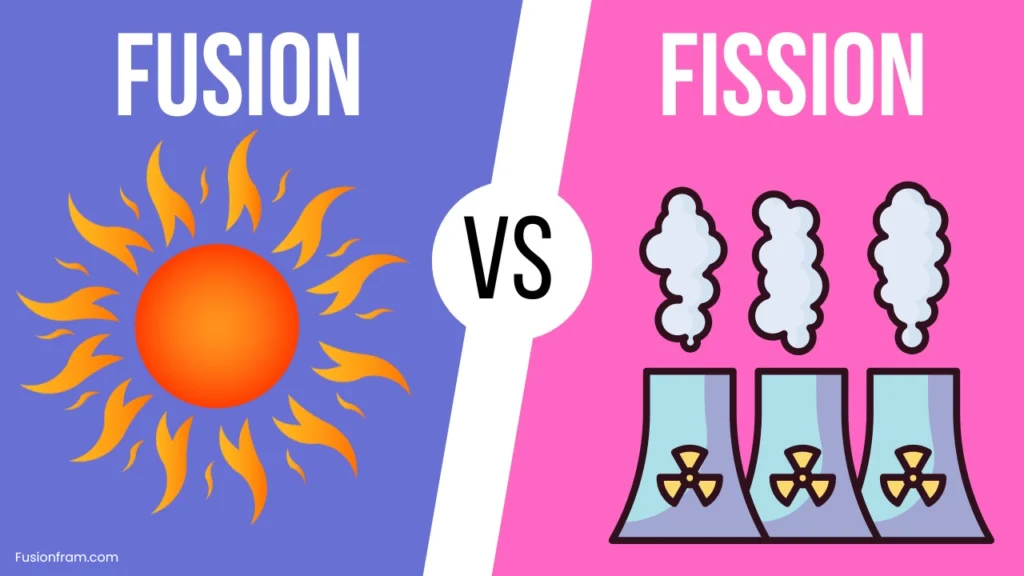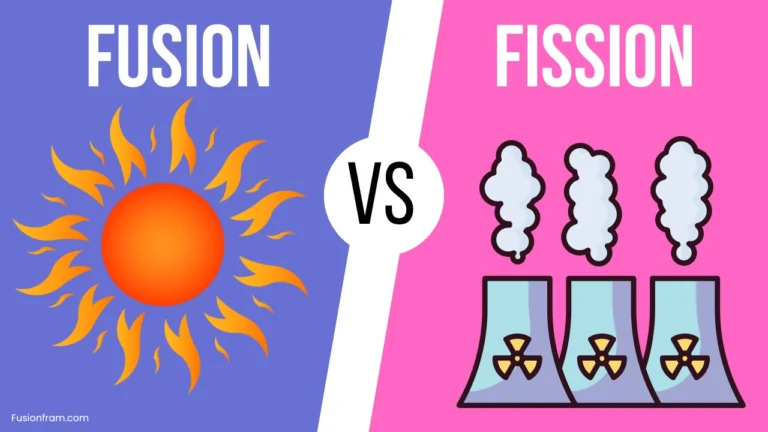
Every energy is a starting point in change. Energy is what drives life whether through combustion or through splitting atoms. The processes with the most power? fission vs fusion. The secret behind such massive power is these nuclear reactions. Both release extreme energy. But how they work—and what they mean—differs greatly.
In this article, we’ll explore what each one is, how they function, their dangers and benefits, and where they lead us. You’ll also learn answers to popular questions like “is the sun fission or fusion?”, and how these compare for school topics like “difference between nuclear fusion and nuclear fission class 10” or “fission vs fusion UPSC”.
What is Fission?
Fission is when a heavy atomic nucleus breaks apart. Usually, a neutron hits an atom like uranium or plutonium. This causes the atom to split. The result? Huge energy, more neutrons, and smaller atoms.
The process is self-sustaining. Neutrons from the first reaction cause others to split. This chain reaction keeps producing energy. That heat is used to turn water into steam. Then, turbines spin and generate electricity. Fission is the working principle behind today’s nuclear power plants.
Fission is efficient. But it creates long-lasting radioactive waste. It also requires very tight safety controls.
Fission Basics
| Characteristic | Details |
| Reaction Type | Nucleus Splitting |
| Fuel | Uranium-235, Plutonium-239 |
| Output | Heat, Neutrons, Radioactive Waste |
| Common Use | Power Plants, Submarines |
| Carbon Emission | Near Zero |
| Risk Level | High |
What is Fusion?
Fusion does the opposite of fission. It combines two small atomic nuclei into one bigger one. Most often, hydrogen atoms fuse into helium. That’s what powers stars. So, is the sun fission or fusion? The answer: fusion.
Fusion needs very high heat and pressure. Over 100 million degrees Celsius. When the nuclei combine, they release massive energy—more than fission. And no long-lasting waste.
The only problem? We haven’t yet figured out how to do it on Earth in a stable, controlled way. But research reactors like ITER are getting closer.
Fusion Overview
| Characteristic | Details |
| Reaction Type | Nucleus Merging |
| Fuel | Deuterium, Tritium (Hydrogen isotopes) |
| Output | Heat, Helium, Low Waste |
| Common Use | Experimental Research |
| Carbon Emission | Zero |
| Risk Level | Very Low |
How Are Fission and Fusion Different?
The key difference in fission vs fusion is how the atoms behave. Fission splits atoms. Fusion joins them. This basic change creates different results in energy, risk, and waste.
Fission is widely used today. Fusion is the dream of tomorrow. The difference is studied in schools and competitive exams. Topics like difference between nuclear fusion and nuclear fission class 10 or fission vs fusion UPSC often focus on this.
Fission vs Fusion Energy Comparison
| Aspect | Fission | Fusion |
| Atom Reaction | Splits nucleus | Combines nuclei |
| Fuel | Uranium, Plutonium | Hydrogen isotopes |
| Energy Produced | Very High | Even Higher |
| Waste Produced | Long-lasting, radioactive | Minimal, short-lived |
| Usage | Common in power plants | Experimental labs |
| Environmental Risk | High | Low |
Fission vs Fusion Bomb: A Deadly Comparison
The Fission and fusion also power some of the most dangerous weapons. Fission bombs were first used in WWII. Fusion bombs, or hydrogen bombs, came later. They’re even more destructive.
A fission bomb works by rapidly splitting uranium or plutonium atoms. The explosion releases intense heat and radiation. Fusion bombs use a small fission explosion to start a fusion reaction. The result? A blast much larger than fission alone.
The energy mechanics behind fission vs fusion bomb are different, but both are devastating.
Fission vs Fusion Energy in Biology
The terms fission and fusion also appear in biology. But they mean different things there. In biology, fission is when a single cell splits into two. Fusion is when two cells or gametes merge.
While unrelated to nuclear science, this shows how universal the ideas of splitting and combining are in science. Understanding this helps in school topics like the difference between fission and fusion in biology.
5 Examples Nuclear Fission and Fusion
Let’s see 5 examples of nuclear fission and fusion in real-world scenarios. This helps understand their roles across fields.
Nuclear Fission Examples:
- Nuclear power stations using uranium rods. These provide electricity to millions.
- Naval submarines powered by nuclear fission. They run for years without refueling.
- Medical isotope production. Fission reactions help diagnose and treat cancer.
- Icebreaker ships powered by nuclear energy. They cut through thick Arctic ice.
- Atomic bombs. Fission was used in Hiroshima and Nagasaki in WWII.
Nuclear Fusion Examples:
- The sun. It runs on fusion and lights up our planet.
- ITER reactor in France. It aims to create stable fusion reactions on Earth.
- Hydrogen bombs. Fusion reactions cause extremely powerful explosions.
- Fusion in labs using laser ignition. Scientists simulate plasma behavior.
- Future fuel source for Mars missions. Fusion promises clean space energy.
Why Is Fusion Difficult But Worth Pursuing?
Fusion seems perfect. But it’s hard. We need very high heat and pressure. That’s tough to achieve and control.
Plasma is the state in which fusion occurs. It’s unstable. Containing it requires massive magnets or lasers. It also costs billions. Still, fusion could solve the world’s energy problems. That’s why many governments keep investing.
Nuclear Planning: Combining Both Methods
Fission vs fusion is not a fight. Both matter. Fission is here. Fusion is coming. Together, they can create a balanced energy plan.
Fission currently powers homes and industries. Fusion could be the backbone of future clean energy.
Nuclear Strategy by Timeline
| Timeframe | Fission Use | Fusion Use |
| Short-Term (Now) | Electricity, Medical | Research Only |
| Mid-Term (2035-2045) | Advanced Reactors (SMRs) | First Demo Reactors |
| Long-Term (2050+) | Backup Source | Global Power Generation |
Risks and Environmental Effects
Fission produces waste that lasts thousands of years. It also risks meltdown. Fusion has fewer risks. Waste is short-lived and non-radioactive.
Environmental Impact
| Factor | Fission | Fusion |
| Waste | High, Needs Storage | Very Low, Short-term |
| Emission | No CO2, but radioactive | No CO2 or long-term waste |
| Cooling Needs | High | Moderate |
| Risk of Explosion | Yes, if not managed properly | Extremely Low |
Fusion is the better option. But until we perfect it, fission will remain.
Fission vs Fusion UPSC & Competitive Relevance
This topic appears often in exams like UPSC and NEET. Knowing the facts helps in science and environment sections.
You should understand mechanisms, comparisons, advantages, disadvantages, and applications of fission vs fusion. Use tables or real-life examples for better answers.
School-Level Understanding: Class 10 Focus
In class 10, the difference between nuclear fusion and fission is a core concept. Questions like the difference between nuclear fusion and nuclear fission class 10 appear in exams.
Fission splits heavy atoms. Fusion joins light atoms. Fission is used today. Fusion will be used tomorrow. This forms the foundation of future science education.
Final Thoughts on Fission vs Fusion
The debate of fission vs fusion isn’t about which is better. It’s about how they work together to solve energy needs.
Fission powers the present. Fusion lights the way forward. From energy security to climate goals, these reactions will shape the next century.
Understanding them now is vital. Whether you’re a student, policymaker, or scientist, knowing the fission vs fusion landscape prepares you for the energy challenges of tomorrow.
With the right investment, we could soon unlock clean, powerful, and limitless fusion energy for all.
FAQs on Fission vs Fusion
Q1. What is the main concept behind fission vs fusion?
Ans. Fission splits a heavy atom like uranium into smaller ones, releasing energy. Fusion merges light atoms like hydrogen into helium, also releasing energy. Both are nuclear reactions, but their mechanics differ completely.
Q2. Is the sun fission or fusion powered?
Ans. The sun is powered by fusion. In its core, hydrogen atoms fuse to form helium, producing light and heat. This natural fusion process fuels our solar system.
Q3. What’s the difference between nuclear fusion and nuclear fission class 10 level?
Ans. For class 10, fission breaks large atoms and produces waste, while fusion joins small atoms and is cleaner. Fission is used in nuclear reactors; fusion happens in stars like the sun.
Q4. Why does fission vs fusion energy matter for the future?
Ans. Fission gives us steady nuclear energy today but with radioactive waste. Fusion could provide limitless clean energy with fewer risks. Understanding both helps us plan cleaner energy strategies.
Read More Blogs:-) MWP Fusion: Transforming Business Workflows



